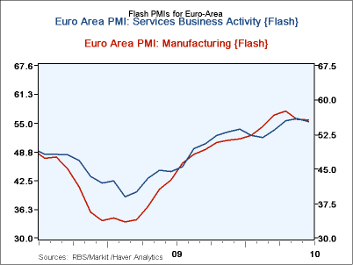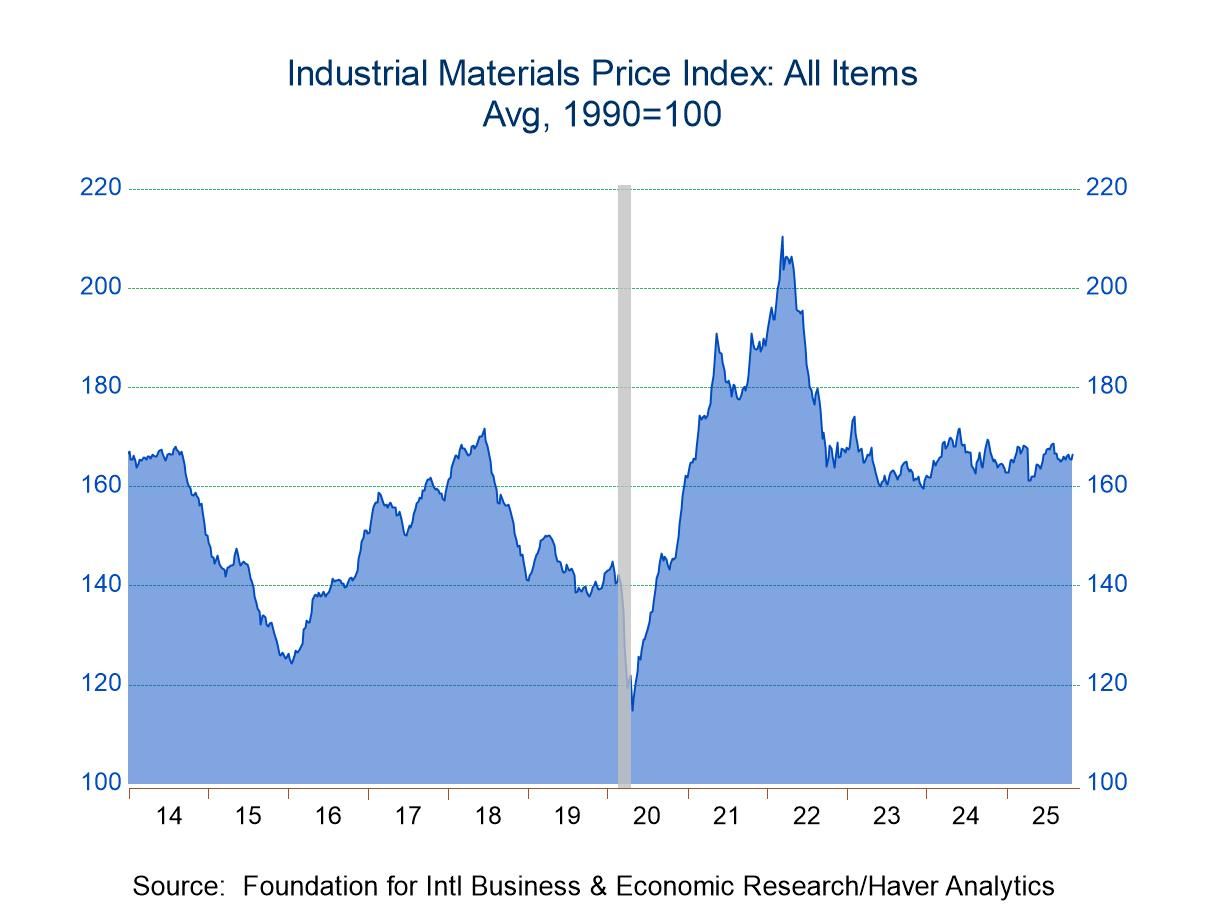 Global| Jun 23 2010
Global| Jun 23 2010EMU PMIs Slow Ascent...MFG PMI Losses Ground
Summary
The PMIs are entering a more mature stage of the expansion and steady monthly increases will no longer be the rule nor will such monthly fluctuations be a 'bad signal,' just the result of normal fluctuation. From April to December of [...]
 The PMIs are entering a more mature stage of the expansion and steady monthly increases will no longer be the rule nor will such monthly fluctuations be a 'bad signal,' just the result of normal fluctuation.
The PMIs are entering a more mature stage of the expansion and steady monthly increases will no longer be the rule nor will such monthly fluctuations be a 'bad signal,' just the result of normal fluctuation.
From April to December of 2008 the Markit PMIs fell. From Dec 2008 though March of 2009 they consolidated at a low level. From March 2009 until August of 2009 they rose, marking a recovery. From Aug 2009-Jan of 2010 the pace of increases slackened in MFG then the rise speeded up though April and now we our first decline in the MFG index. The services PMI is more or less on the same track except in Dec of 2009 it hit a local peak then dropped or moved sideways before renewing its growth.
The MFG reading reached the 89th percentile of its range in April but in May it has slid to the 82nd percentile. The services measure has climbed to the 73rd percentile of its range in May. The MFG index has risen enough that it is near the top of its queue of values. For example in April the MFG reading stood in the 93.7 percentile of queue-that is, it had only been stronger 7% of the time. But the small drop in the index in May has dropped it back to the 89th percentile of its queue. Services lag this performance and reside in the 66th percentile of their queue at the border of the top one-third. Services have a ways to go to restore operation at a top level.
The point is that the steady-to-strong path of month-by-month increases in these indices is a thing of the past. The recovery has matured. Holding to values this high will be good performance in and of itself for manufacturing. We should be careful about assuming that reaching a peak means heading for a new trough as the double-dippers think. It is quite possible for these indicators to stay in a high range for some time. The services gauge still has plenty of room to move up and it should do that as the recovery completes itself. Manufacturing simply has to run at these levels for a while to bring output and jobs in that sector up to past levels.
| FLASH Readings | ||
|---|---|---|
| Markit PMIs for the Euro-Area | ||
| MFG | Services | |
| May-10 | 55.84 | 56.02 |
| Apr-10 | 57.57 | 55.60 |
| Mar-10 | 56.65 | 54.08 |
| Feb-10 | 54.23 | 51.81 |
| Segment averages | ||
| 3-Mo | 56.15 | 55.06 |
| 6-Mo | 53.94 | 53.87 |
| 12-Mo | 50.12 | 51.58 |
| 140-Mo Range | ||
| High | 60.47 | 62.36 |
| Low | 33.55 | 39.24 |
| % Range | 82.8% | 72.6% |
| range: | 26.92 | 23.12 |
| AVERAGE | 51.20 | 53.66 |
Robert Brusca
AuthorMore in Author Profile »Robert A. Brusca is Chief Economist of Fact and Opinion Economics, a consulting firm he founded in Manhattan. He has been an economist on Wall Street for over 25 years. He has visited central banking and large institutional clients in over 30 countries in his career as an economist. Mr. Brusca was a Divisional Research Chief at the Federal Reserve Bank of NY (Chief of the International Financial markets Division), a Fed Watcher at Irving Trust and Chief Economist at Nikko Securities International. He is widely quoted and appears in various media. Mr. Brusca holds an MA and Ph.D. in economics from Michigan State University and a BA in Economics from the University of Michigan. His research pursues his strong interests in non aligned policy economics as well as international economics. FAO Economics’ research targets investors to assist them in making better investment decisions in stocks, bonds and in a variety of international assets. The company does not manage money and has no conflicts in giving economic advice.






